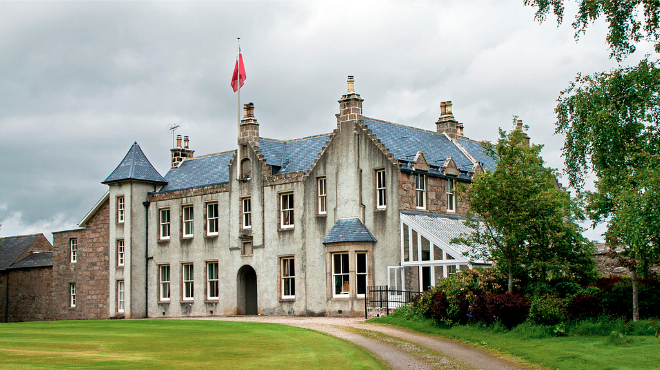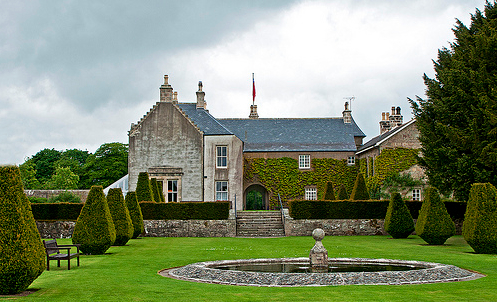 John
Seton was the first of the family of the Meldrum line, to have
acquired the Estate and Barony of Pitmedden, sometime before his
death in 1628. His son and heir Alexander Seton, 2nd of Pitmedden, had a charter disponed to him
of the estate of Barra by William Seton, last of Meldrum in 1630. He was
succeeded in Pitmedden by his eldest son, John, and his second
son Alexander Seton (b.1600, d.c.17.04.1660), younger of Pitmedden,
was Minister of the Parish of Banff.
John
Seton was the first of the family of the Meldrum line, to have
acquired the Estate and Barony of Pitmedden, sometime before his
death in 1628. His son and heir Alexander Seton, 2nd of Pitmedden, had a charter disponed to him
of the estate of Barra by William Seton, last of Meldrum in 1630. He was
succeeded in Pitmedden by his eldest son, John, and his second
son Alexander Seton (b.1600, d.c.17.04.1660), younger of Pitmedden,
was Minister of the Parish of Banff.
John
Seton, 3rd of Pitmedden (d. 1639), was the celebrated "Bonnie John Seton",
who died at the Bridge of Dee, carrying the Royal Standard in his hands, and
was buried with military honours by the Earl of Montrose.
His son and heir, James
Seton, 4th of Pitmedden (d 1667, sp.), was raised by George Seton, 3rd Earl of
Winton and attended Marischal College along with his brother. He sold the estate of Bourtie
to Advocate James Reid of Aberdeen in 1657. After some travel in
Europe, he served and died in the Navy under the Duke of York, of wounds received in the attack on Chatham in
the Second Dutch War, and was succeded by his brother, Alexander.
Sir Alexander Seton succeeded to Pitmedden as
5th of Pitmedden, and became later, 1st Baronet of Pitmedden
and Lord Pitmedden of the Court of Justice. It was he who
developed the Estate and founded the Great
Garden of Pitmedden in the years around 1675.
The garden, with its pavilions and fountains
and manicured look, was established as a magnificent formal
geometric garden within a walled square and divided into four
Parterre's.
It is likely that Seton would have known the architect Sir William
Bruce, who had visited France and seen the gardens at Versailles,
and as Bruce laid out the gardens at nearby Balcaskie and at his
new house in Kinross, it may be that he influenced Seton in
his layout of the Pitmedden Garden.
The lower part of the garden has four Parterres one of which
was in modern times designed by Dr James Richardson as a tribute
to Sir Alexander Seton. The parterre has the Seton of Pitmedden
Coat of Arms in the centre, surrounded by the Pitmeddden mottos: "Sustento
Sanguie Signa" (With blood I bear the standard); and "Merces Haec
Certa Laborum" (This sure reward of our labours). This is flanked
by a thistle and saltire on each side.
Another has a sundial and floral depiction of
the well-known Latin dictum, "Tempus Fugit", and the eastern half
of the square modelled on the Charles II garden at the Palace of Holyroodhouse in
Edinburgh.
The multi-faceted sundial and one of the
pavilions with its sundial, is in the centre of the southeast
parterre, and is thought to contemporary with the original garden.
The garden is divided into an upper and lower terrace by a
retaining wall at each end of which there stands a gazebo or
garden pavilion similar to those that are found at Hatton House in
Midlothian.
The house
itself had been badly damaged by fire in 1818 but was rebuilt
during the 1860's. Today, only the north wing contains visible
fragments of the 17th century grand dwelling. It has been well
documented that the fire caused the destruction of family
portraits, papers and the, all important, plans of the original
layout of the Garden. Indeed, the Trust is still keen to discover
references to, or sketches of Seton's Great Garden in its earlier
years.
 The Keith family bought the Pitmedden Estate at auction in 1894.
Major James Keith CBE (1879 - 1953) was one of the country's most
influential agricultural improvers of his time, with a desire to
combine traditional farming methods with the increasing
sophistication of mechanical engineering. A shrewd businessman,
keen to increase productivity, Keith successfully evolved his own
style of farming.
The Keith family bought the Pitmedden Estate at auction in 1894.
Major James Keith CBE (1879 - 1953) was one of the country's most
influential agricultural improvers of his time, with a desire to
combine traditional farming methods with the increasing
sophistication of mechanical engineering. A shrewd businessman,
keen to increase productivity, Keith successfully evolved his own
style of farming.
His expectations of his Garden would surely have
matched those of his many farms so it is of no surprise that what
the Trust inherited in 1952 was a magnificent working market
garden producing fruit and vegetables in abundance
Major Keith, in a single act of munificence in 1952, presented to
the National Trust for Scotland the Pitmedden Estate comprising
the house, the walled garden, ancillary buildings, 100 acres of
woodland and farmland, together with an endowment fund to provide
for its upkeep. In 1978 the Trustees of William Cook of Little
Meldrum, Tarves presented to the Trust the extensive collection of
agricultural and domestic artifacts which Mr. Cook had amassed in
his lifetime.
When it was acquired by The National Trust for Scotland in 1952
they inherited a working market garden which had been developed by
James and Alexander Keith over the first half of the twentieth
century. This garden was set within the lower part of a much older
garden.
The Great
Garden of Pitmedden has been celebrating fifty years in the care
of the National Trust for Scotland in 2002. Pitmedden is situated
in the heart of rural North-East Aberdeenshire, 15 miles north of
the "granite city" Aberdeen. It is no coincidence therefore, that
this magnificent Grade A listed Walled Garden was created using
the finest granite.
The Garden has been lovingly restored by the
National Trust. Pitmedden House also has a museum of family life,
a collection of farming tools and domestic utensils, and there are
woodland walks on the 100 acre estate, as well as an exhibition on
Formal gardens.

